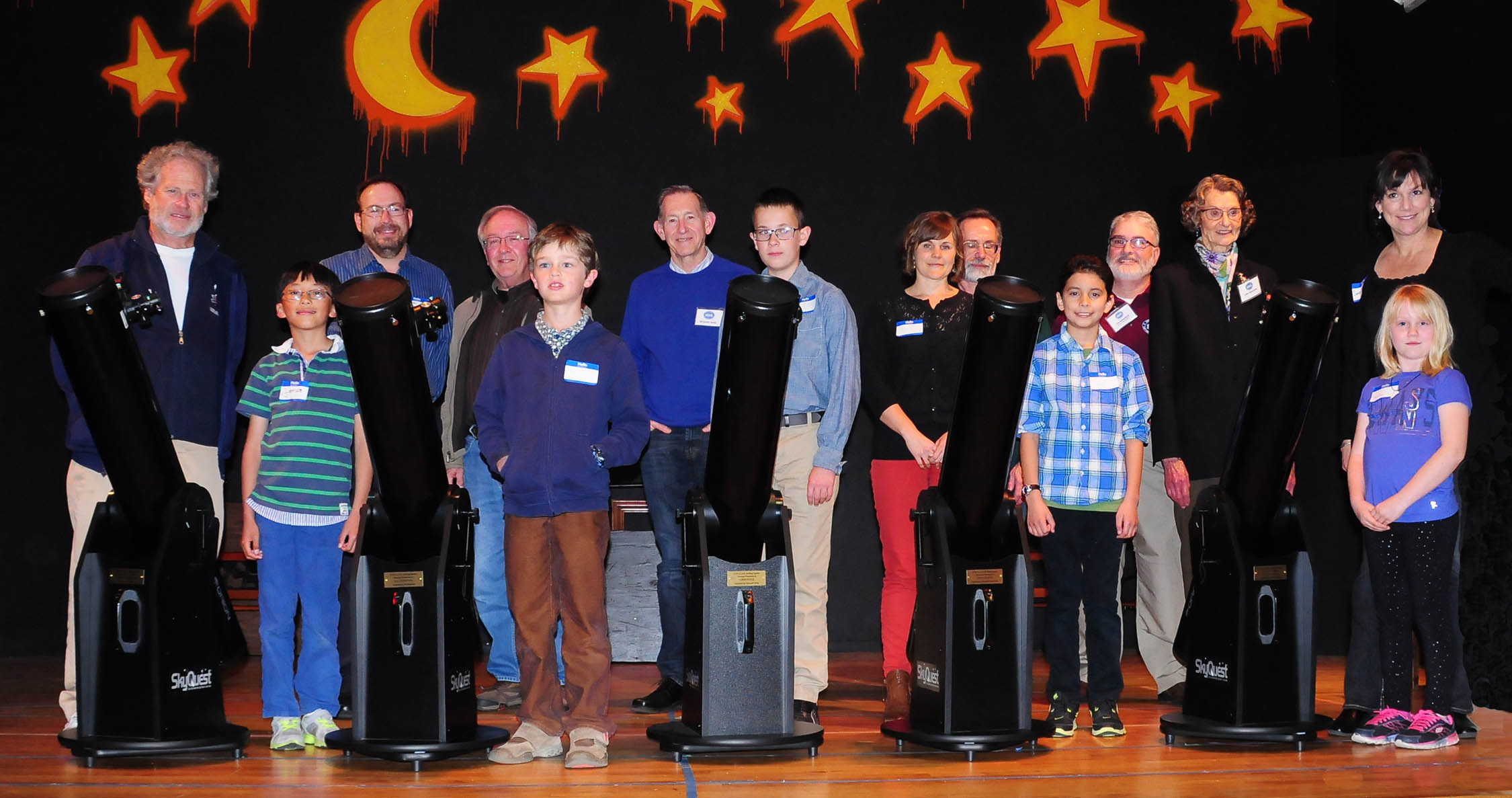
 Orion is proud to partner with BBC Sky at Night Magazine, the UK's biggest selling astronomy periodical, to bring you this article as part of an ongoing series to provide valuable content to our customers. Check back each month for exciting articles from renowned amateur astronomers, practical observing tutorials, and much more!
Orion is proud to partner with BBC Sky at Night Magazine, the UK's biggest selling astronomy periodical, to bring you this article as part of an ongoing series to provide valuable content to our customers. Check back each month for exciting articles from renowned amateur astronomers, practical observing tutorials, and much more!
Is your son or daughter the next Patrick Moore? We look at ways you can encourage the astronomers of the future!

Winners of the 2015 SCAS Striking Sparks program pose with their Orion XT6 Classic Dobsonian telescope awards alongside proud sponsors, teachers and parents.
Ever since I can remember I have loved astronomy. As a boy of seven I used to gaze out of the window at the stars, curious about their names and the patterns that make the constellations. I learned much by myself, but it wasn't until I started at secondary school that, through some friends, I was introduced to our local astronomical society.
If, as a child, you had particularly encouraging parents who already knew something about the subject or were curious enough to learn with you, you were off to a good start. Joining an astronomical society is the perfect next step in the stargazing journey. These clubs offer friendship and experience — not to mention access to telescopes — and could even provide the spark that leads to a career in astronomy.
Summer Stargazing
Many societies take a break in August, but that's not because there's no astronomy to be done. In fact, for kids especially, this time of year has quite a number of benefits for stargazing. Though it doesn't get dark until fairly late there's no school to worry about, so a couple of late bedtimes on clear, starry nights hopefully won't be too much of a problem. Plus, the nights are usually considerably warmer at this time of year, so even though you still have to wrap up, you don't need to suffer the coldness associated with winter stargazing.
You don't need a telescope either: many fine deep-sky objects, such as globular cluster M13 in Hercules or the Coathanger asterism in Vulpecula, can be seen with a good pair of binoculars.
On that note, though, one thing that has massively improved since my early stargazing days is technology. One great tool is the video telescope eyepiece. This is linked to a screen to give live feeds of what the telescope is seeing &mash; particularly handy if you're out stargazing with several children and would rather not have them come to the eyepiece single file.
If you're thinking of running a star party for your kids, make sure you have a back-up plan in case the weather takes a turn for the worse. A space quiz with some chocolate prizes goes down a storm!
Wow-Factor Sights
The Milky Way
Equipment: Naked eye.
Where it is: Visible from summer through Christmas, running across the sky from the south to southwestern horizon.
What you'll see: A misty meandering river of light — it's made up of the combined light from millions of stars. For the best views, head out to a countryside location.
Fun fact for kids: This is just the visible section of our Galaxy, which contains between 200 and 400 billion stars in total.
The Pleiades
Equipment: Naked eye or binoculars.
Where it is: In the constellation of Taurus, the Bull.
What you'll see: This open cluster is known as the Seven Sisters, which is roughly the number of stars you can see with the naked eye. It's also a lovely sight in binoculars, which will reveal several dozen more stars.
Fun fact for kids: This family of several hundred stars sits about 400 lightyears from Earth.
The Moon
Equipment: Binoculars or telescope.
Where it is: Varies, but close to the ecliptic.
What you'll see: Head outside when the Moon is in a crescent or gibbous phase to see craters, mountains, valleys, escarpments, rilles and more. Steer clear of the time around full Moon - there are too few shadows to reveal the incredible surface detail on our satellite.
Fun fact for kids: The surface of the Moon covers roughly the same area as Africa.
Great Events for Kids
Be Galileo (or Einstein, or whoever!)
Instead of just having a general talk on, say, Galileo, why not ask around the club for someone with thespian tendencies? They could dress up and play the famous Italian astronomer, describing his own inventions and discoveries. It's a simple way to liven up the subject for young minds and you could have a lot of fun, too.
Treasure hunts
One meeting could be created as a themed 'mission', with stations around the society's hut or field containing challenges that need to be solved to complete the mission. By doing so, the younger members of the club would get to understand some aspect of astronomy. Each station could hold riddles, puzzles or simple questions.
Space writing, poetry or drawing competition
You don't need to narrow this one down, just allow minds to run wild! The competition could be inspired by a talk, such as the 'Be Galileo' event. You could also open it up to local schools, in which case the local newspaper might be interested. Put up a small telescope as a prize and the publicity could bring in some new faces to your club.
Copyright © Immediate Media. All rights reserved. No part of this article may be reproduced or transmitted in any form or by any means, electronic or mechanical without permission from the publisher.






 /
/ 







